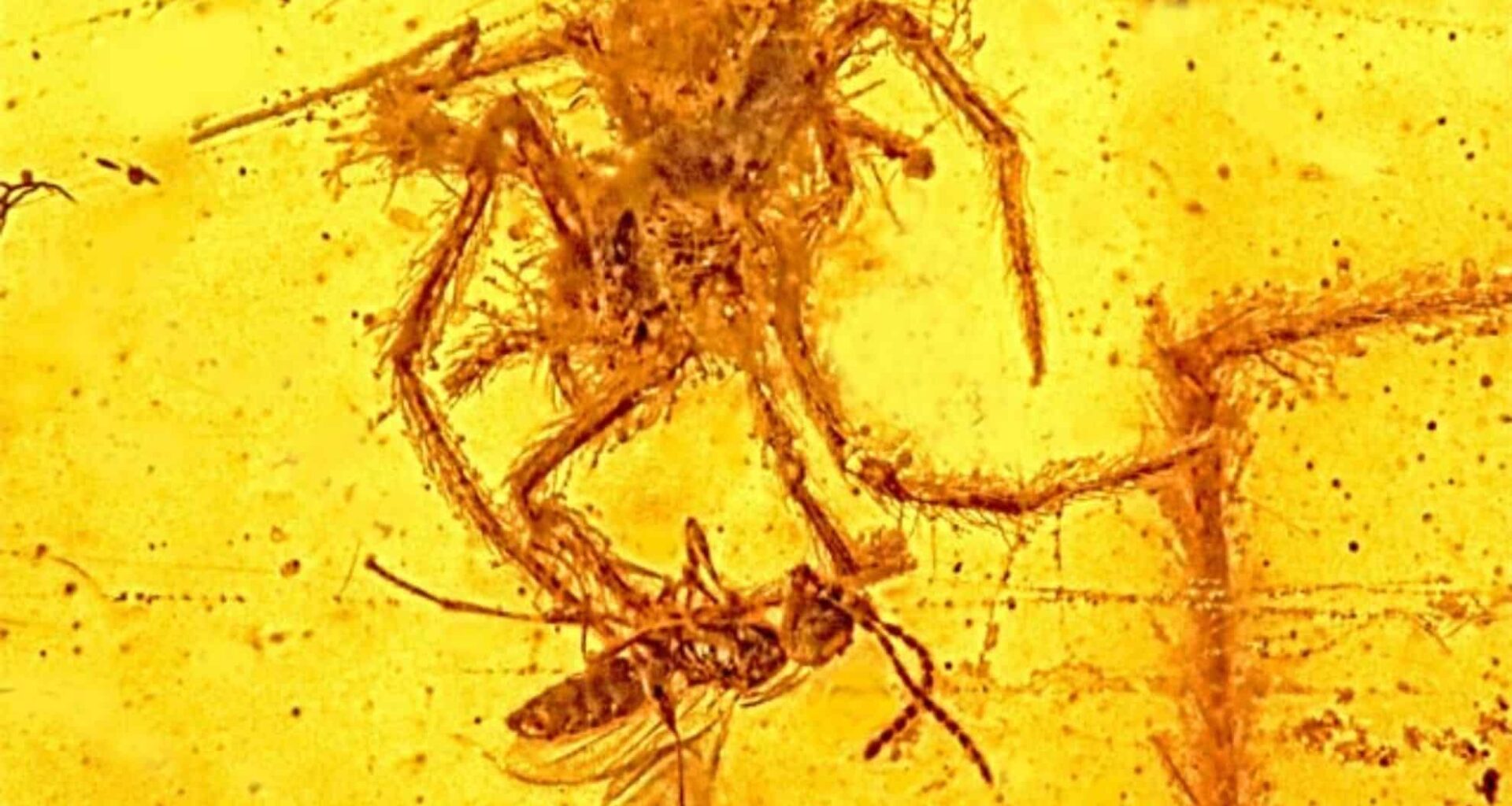A new paleontological discovery, as reported in the Historical Biology journal, has shed light on a fascinating scene from the Cretaceous period—a spider’s predatory attack on a wasp, preserved in amber. This discovery offers an extraordinary glimpse into the behaviors of ancient arachnids and their ecological roles, providing valuable insights into the ancient predator-prey relationships. The fossil, about 100 million years old, was discovered in Myanmar’s Hukawng Valley, and it is the only known example of a spider attacking prey within its web.
A Fossilized Moment in Time: Preserved Predation
This amber fossil offers a rare and extraordinary glimpse into the moment of predation, preserved with remarkable precision. The amber trapped both the spider and the wasp at the very moment before the spider could strike. The tree resin that encased them swiftly flowed over the creatures, entangling both the predator and its prey in its sticky grasp before the spider could deliver the fatal blow. This fossil is unique because it preserves an actual moment of predation—the spider in its web, preparing to attack, and the wasp, realizing it was trapped. The fossilized resin captures the tension and anticipation in the environment, offering scientists an unparalleled opportunity to study the interactions between these ancient creatures.
What sets this discovery apart is its exceptional detail. Unlike other fossilized remains that often provide only fragments or partial evidence of past life, this amber specimen offers a full scene of an insect caught in a web just before it meets its end. The amber’s ability to capture these fleeting moments makes it invaluable to paleontologists studying ancient ecosystems. This discovery also highlights the incredible preservative properties of amber, which allows for the retention of fine details such as the delicate structure of the spider’s silk strands, the positioning of the wasp, and even the minute features of the species themselves.
Unveiling Social Behavior in Spiders
The presence of a male spider in the same web as the attacking juvenile spider is another fascinating aspect of this find. This evidence provides the oldest recorded instance of social behavior in spiders, an incredibly rare occurrence in a group that is mostly solitary and, in many cases, cannibalistic. Most spider species lead solitary lives, with males and females only meeting to mate, and sometimes even engaging in cannibalistic behavior after mating. However, some species, particularly those in the orb-weaving family, exhibit more complex behaviors, including communal living and even cooperation in certain circumstances.
The discovery of this male spider in the same web as the juvenile spider challenges the conventional understanding of spider behavior in the Cretaceous period. It opens up new avenues for researching how and why some spiders may have formed social bonds, an aspect that could have implications for the evolutionary history of arachnids. “This juvenile spider was going to make a meal out of a tiny parasitic wasp, but never quite got to it,” said Prof. George Poinar Jr., an expert on insects trapped in amber. His comments point to the immediate predatory behavior of the spider, but the existence of two spiders in the same web indicates that, despite their solitary nature, some spiders might have engaged in limited social behaviors or perhaps competed for territory and prey.
The Wasp’s Final Moments and the Science of Amber
The wasp, trapped in the web, is described as a male of a species that parasitizes spider and insect eggs. Prof. Poinar remarked that “This was a male wasp that suddenly found itself trapped in a spider web,” underscoring the vulnerability of the wasp as it became ensnared. The wasp’s predicament is chilling—it was stuck, fully aware of the danger it faced as the spider moved in for the kill. However, the tragic conclusion for the wasp was never realized because of the rapid flow of tree resin that preserved the scene. “This was the wasp’s worst nightmare, and it never ended,” Prof. Poinar continued, highlighting the horrific yet fascinating nature of the fossil. As the spider approached its prey, the resin covered both the spider and the wasp, essentially freezing the moment before the attack could take place.
The wasp belongs to a group known today for parasitizing spider eggs and larvae. This type of parasitism is common in some species of wasps, which lay their eggs inside or on the bodies of other arthropods. The fact that this particular wasp was about to fall prey to a spider adds a layer of irony to the fossil—a parasitic wasp encountering an unexpected reversal of roles. The predator-prey relationship in this fossil may suggest that spiders were not only preyed upon by certain wasp species but also actively hunted those very species.
Spiders: Ancient Invertebrates with a Rich Evolutionary History
Spiders are among the oldest invertebrates, with fossil evidence suggesting they have existed for over 200 million years. Despite their long evolutionary history, the oldest known fossil evidence of spider webs dates back only 130 million years. The discovery of this amber fossil featuring an actual predatory attack is particularly significant, as it is the first known example of a spider actively attacking prey in its web preserved in the fossil record. “Spiders are ancient invertebrates that researchers believe date back some 200 million years,” Prof. Poinar remarked. “However, the oldest fossil evidence ever found of a spider web is only about 130 million years old. An actual attack such as this between a spider and its prey caught in the web has never before been documented as a fossil.”
